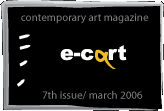Project
vs art work?
In a desperate attempt to stimulate production of anything vaguely
looking like contemporary art in Russia, I recently established a seminar
for young artists, or, to be more precise, for young people who were
considering a possibility of eventually becoming artists (rather than
making a more lucrative career of a designer or a journalist). I called
the seminar "Project" and encouraged my students-to-be to
share their fragile ideas with others. I told them I mean projects of
any kind, the crazier the better. When I saw they were not actually
inclined to craziness, I suggested to them to remember their hobbies,
such as cooking, in order to reconnect with what they really like and
to make a piece of art out of it. Normally, I don't especially trust
artists feeding/shaving/entertaining critics for free and assuming this
will make them happy, but one has to start with something, and to narrow
the horizon to everyday experience of hesitating artists seemed realistic.
But I was wrong. Weeks later, I still had not heard af a single project.
Then one girl finally announced she had one. "You know, I met a
guy. He's a brother of a friend. And he has money, lots of. He's a businessman.
And he wants to support something. He just does not know what exactly.
A film club, an exhibition... So I thought this could be my project,
after all".
Behind the idea of a project, there is often an idea of getting a sponsorship.
There is nothing specifically bad about it - behind any painting there
might be the same material wish. It is just that the economy of a project
is different. For a painting/sculpture/print, i.e. an art work in a
classical sense (no matter how non-classical it may look), you can normally
get money when it is finished - and sold. For a project, you are usually
getting support before actually starting. The classical art work, like
a naturalist painting, thus runs a danger of being "overdone";
the typical project is exposed to a danger of never beginning. Maybe
the notion of the project which now dominates contemporary art scene
and education implies more than just a terminological switch, and we
have to reevaluate some notions. Do they still apply to our situation?
1. First, the emergence of a project created a new zone of commercial
art. We are used to smell the danger with art which sells well, but
there is also the one which is being financed well. Some fake social
and political initiatives we are already used to see at art exhibitions
fall into this category. We should not forget that the notion of the
project emerged in Soviet communist context, outside the private art
market, in the necessarily state-sponsored system where artists had
careers rather than personal wealth. This is why contemporary post-Soviet
art scene is usually wary of social projects, political art and activism,
seeing them as calculated career moves and en expression of impardonable
opportunism.
2. Second, the notion of quality becomes vague. A project is an ongoing
process rather than a tangible result, an initiative rather than a masterpiece;
this future-oriented instability eludes critical judgement as something
being necessarily rooted in past criteria. But we also underestimate
the conscious sabotaging impulse of any project, its profound hostility
towards bourgeois notion of quality. It was the ambition of destroying
the division of labour that engendered the idea of a project as a product
of a free creativity ("sign of our constant movement", how
Malevich put it) which replaced the outdated 'art work' or 'art object',
now questioned as an expression of commodity fetishism. A project falls
in the category of subjects rather than objects - it is not opposed
to the artist, but is close to him or her as a friend, a relative, a
part of him/herself. Two projects are different to the extent their
authors are different, and, as a result, the critical judgement - unavoidably,
judgement of comparison - becomes less and less legitimated, and even
less and less ethical.
3. This is why the notion of critique also requires a sober look. We
often delude ourselves and others by claiming an artist is "critical"
to something, "questions" or even "investigates"
something - these words became a pass into the art world, a stamp of
quality. The one who is not questioning anything is simply not O.K.
But it is a well known secret that the contemporary artist, artist of
projects, is usually being motivated by what he likes, by his manias
and obsessions, which are about fascination rather than doubt. One of
the most prominent Russian artists of the 90s project-oriented generation,
Anatoli Osmolovski, now claims the only way to restore the critical
ability of art is to return to an almost greenbergean idea of an art
work (a sculpture, in his case) which is already there, is done, exists
under the conditions of the private market but does not bend to them.
Do we really need more formalism?
4. The crisis of the critique was also connected to the emergence of
the figure of the freelance curator involved in the process of art (or,
rather, project) production and not just reception, often as an initiator,
an inspiring force or even as the customer who places a specific order.
Robert Storr in his recent columns for Frieze magazine was explicite
about this situation we all know. We almost need now, in art education,
two teachers for every student - the one of the skill, of the 'how',
and the one of the content, of the 'what' - it reminds me of Red Army
where, in early years, there alwas was a commander dealing with less
important issues like how to win over the enemy, and a commissar deciding
about things of an extreme importance, like why bother at all. Dividing
the sphere of competence into these two parts, we are thus preparing
an artist for his future involvement with a curator (a commissaire of
the exhibition, using a common French term) who will provide him with
topics and ideas, and, eventually, assistants who will realize his project
on a material level.
My answer to this situation would be to switch from the "how"
and the "what" questions to the question of the "who".
As art teachers or curators, we cannot make an artist out of someone
who is not one already. A project is only valid when it is a lifelong
one - not just a swift tactical response to the topic of the day.
Ekaterina Degot
art critic based in Moscow, curator ("Moscow-Berlin 1950-2000",
"Body Memory: Underwear of the Soviet Era", "Comedy:
The Funny Side of the Moving Image", "Soviet Idealism: Painting
and Film 1925-1939", a.o.)
 |
|
|
||||||||||||||||||||
 |
 |
 |
|
|||||||||||||||||||
| |
|
|||||||||||||||||||||
 |
|
 |
|
|||||||||||||||||||
 |
|
|||||||||||||||||||||
| |
|
|||||||||||||||||||||
 |
 |
|
|
|||||||||||||||||||
 |
 |
 |
|
|||||||||||||||||||
| |
 |
|
|
|||||||||||||||||||
 |
|
|||||||||||||||||||||
 |
|
|||||||||||||||||||||
| |
|
|
|
|||||||||||||||||||
| |
|
|
|
 |
|
|||||||||||||||||
| |
|
|||||||||||||||||||||
| |
|
|||||||||||||||||||||
| |
|
|
||||||||||||||||||||
 |
|
|||||||||||||||||||||
| |
 |
 |
|
|||||||||||||||||||
| |
 |
|
|
|||||||||||||||||||
 |
|
|||||||||||||||||||||
 |
|
|||||||||||||||||||||
 |
|
|||||||||||||||||||||
| |
|
|
|
|
|
|
|
|
|
|
|
|
|
|
|
|
|
|
|
|
|
|